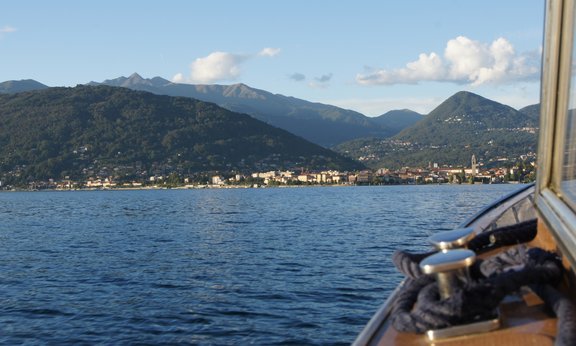The temperature in lakes is also subject to the continuous warming of the climate. As water temperature increases, gas diffusion at the surface of lakes decreases and thus, the oxygen concentration in the lake decreases as well. Ruben Sommaruga and more than 40 scientists from all over the world studied the oxygen concentration in relation to temperature in 393 lakes over a period of more than 70 years. A total of 45,000 combined profiles of temperature and oxygen were analyzed. This close collaboration was made possible by the Global Lake Ecological Observatory Network (GLEON), a global consortium that first raised these questions after a meeting in Gaming, Austria, in 2016. "Global warming is warming the water surface, which in turn is causing less oxygen to diffuse into the lakes. We knew of this process but whether this trend is significant and widespread was unknown. In addition, we wanted to investigate what was happening with changes in oxygen concentration in the depth of the lakes and to identify what factors or processes influence the trends," Sommaruga said. The scientists focused on analyzing profiles of the water column rather than just temperature and oxygen data from the surface water. "Our goal was to look at the entire lake because we expected different trends," clarifies the ecologist from the University of Innsbruck. A central finding of the extensive study is that dead zones spread not only in marine areas, such as the mouth of the Po River into the Adriatic Sea, but also in lakes, and many times faster and stronger than previously thought. According to the published study, the loss trend of oxygen in lakes is up to nine times stronger than in the sea. "Deep blue lakes look beautiful. But at the bottom of many of them a bomb is ticking, the loss of oxygen caused by global warming," says Sommaruga.
Biodiversity in danger and dramatic changes in lakes
As the concentration of oxygen decreases, most life forms also disappear, as it is the most important parameter controlling biodiversity decline in those lakes. "Only few eukaryotic unicellular organisms and prokaryotes can survive without oxygen. All large forms of life disappear," says Sommaruga, who specifies that in addition to this drastic effect, the entire nutrient cycle in the lake change, as he also observes together with his team in the local Lake Piburg. But it is not only the living organisms that are deprived of the basis of life with the reduction in oxygen concentration. Basically, the researchers observed a deterioration in water quality, which is especially important for lakes and reservoirs that are also used for drinking water. "Ultimately, the concentration of greenhouse gases in the water also increases," explains the ecologist. Further, due to the climatic warming, the temperature difference (stratification strength) between the surface and deep-water layers in a lake has also increased. This has as a consequence that lakes sometimes do not mix completely over long periods and that oxygen does not reach the deep layers. At the same time, other processes also increase the loss of oxygen in the deep water layers. Eutrophication, an over-fertilization of lakes with essential nutrients such as nitrogen and phosphorus derived mainly from agriculture in the immediate vicinity of lakes, causes additional problems. "Limnologists speak of a well-fed lake in which algal growth is thus promoted," says Sommaruga, who emphasizes that "algae do produce more oxygen in the upper water layers in the lake through photosynthesis, but when they die, they sink to the bottom of the lake, where the subsequent decomposition process then consumes a lot of oxygen again." This unfavorable combination of effects results in an additional negative oxygen trend in deep water layers for lakes, which the scientists were able to confirm statistically. Especially species that are adapted to cold, oxygen-rich waters will have increasing difficulty surviving. "The decrease of oxygen in lakes has negative consequences for the basic function of the lake, its water quality and biodiversity," the ecologist concludes. However, there is little that can be done directly to counteract this, even if, for example, the fertilization of fields in the immediate vicinity of certain lakes has already been restricted or banned in order to protect lakes and halt the trend. The progressive decrease of oxygen in lakes will severely damage biodiversity in the long term.
Publikation: Widespread deoxygenation of temperate lakes. Stephen F. Jane, Gretchen J. A. Hansen, Benjamin M. Kraemer, Peter R. Leavitt, Joshua L. Mincer, Rebecca L. North, Rachel M. Pilla, Jonathan T. Stetler, Craig E. Williamson, R. Iestyn Woolway, Lauri Arvola, Sudeep Chandra, Curtis L. DeGasperi, Laura Diemer, Julita Dunalska, Oxana Erina, Giovanna Flaim, Hans-Peter Grossart, K. David Hambright, Catherine Hein, Josef Hejzlar, Lorraine L. Janus, Jean-Philippe Jenny, John R. Jones, Lesley B. Knoll, Barbara Leoni, Eleanor Mackay, Shin-Ichiro S. Matsuzaki, Chris McBride, Dörthe C. Müller-Navarra, Andrew M. Paterson, Don Pierson, Michela Rogora, James A. Rusak, Steven Sadro, Emilie Saulnier-Talbot, Martin Schmid, Ruben Sommaruga, Wim Thiery, Piet Verburg, Kathleen C. Weathers, Gesa A. Weyhenmeyer, Kiyoko Yokota & Kevin C. Rose.

